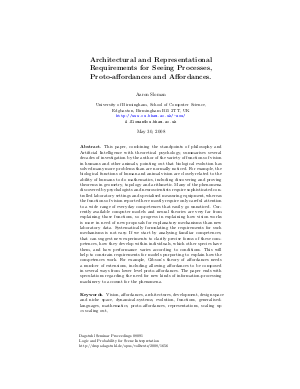Architectural and Representational Requirements for Seeing Processes, Proto-affordances and Affordances
Author Aaron Sloman
-
Part of:
Volume:
Dagstuhl Seminar Proceedings, Volume 8091
Part of: Series: Dagstuhl Seminar Proceedings (DagSemProc) - License:
 Creative Commons Attribution 4.0 International license
Creative Commons Attribution 4.0 International license
- Publication Date: 2008-11-05
File

PDF
DagSemProc.08091.4.pdf
- Filesize: 0.52 MB
- 57 pages
Document Identifiers
Subject Classification
Keywords
- Vision
- affordances
- architectures
- development
- design space
Metrics
- Access Statistics
-
Total Accesses (updated on a weekly basis)
0PDF Downloads0Metadata Views
Abstract
This paper, combining the standpoints of philosophy and Artificial Intelligence with theoretical psychology, summarises several decades of investigation by the author of the variety of functions of vision in humans and other animals, pointing out that biological evolution has solved many more problems than are normally noticed. For example, the biological functions of human and animal vision are closely related to the ability of humans to do mathematics, including discovering and proving theorems in geometry, topology and arithmetic. Many of the phenomena discovered by psychologists and neuroscientists require sophisticated controlled laboratory settings and specialised measuring equipment, whereas the functions of vision reported here mostly require only careful attention to a wide range of everyday competences that easily go unnoticed. Currently available computer models and neural theories are very far from explaining those functions, so progress in explaining how vision works is more in need of new proposals for explanatory mechanisms than new laboratory data. Systematically formulating the requirements for such mechanisms is not easy. If we start by analysing familiar competences, that can suggest new experiments to clarify precise forms of these competences, how they develop within individuals, which other species have them, and how performance varies according to conditions. This will help to constrain requirements for models purporting to explain how the competences work. For example, Gibson’s theory of affordances needs a number of extensions, including allowing affordances to be composed in several ways from lower level proto-affordances. The paper ends with speculations regarding the need for new kinds of information-processing machinery to account for the phenomena.
Cite As Get BibTex
Aaron Sloman. Architectural and Representational Requirements for Seeing Processes, Proto-affordances and Affordances. In Logic and Probability for Scene Interpretation. Dagstuhl Seminar Proceedings, Volume 8091, pp. 1-57, Schloss Dagstuhl – Leibniz-Zentrum für Informatik (2008)
https://doi.org/10.4230/DagSemProc.08091.4
BibTex
@InProceedings{sloman:DagSemProc.08091.4,
author = {Sloman, Aaron},
title = {{Architectural and Representational Requirements for Seeing Processes, Proto-affordances and Affordances}},
booktitle = {Logic and Probability for Scene Interpretation},
pages = {1--57},
series = {Dagstuhl Seminar Proceedings (DagSemProc)},
ISSN = {1862-4405},
year = {2008},
volume = {8091},
editor = {Anthony G. Cohn and David C. Hogg and Ralf M\"{o}ller and Bernd Neumann},
publisher = {Schloss Dagstuhl -- Leibniz-Zentrum f{\"u}r Informatik},
address = {Dagstuhl, Germany},
URL = {https://drops.dagstuhl.de/entities/document/10.4230/DagSemProc.08091.4},
URN = {urn:nbn:de:0030-drops-16569},
doi = {10.4230/DagSemProc.08091.4},
annote = {Keywords: Vision, affordances, architectures, development, design space}
}
